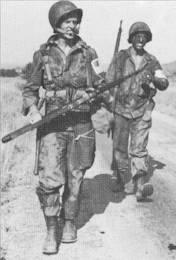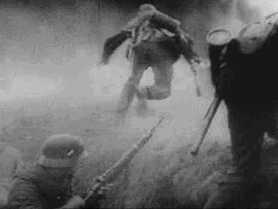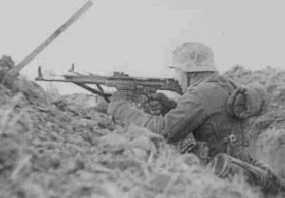




     |
Risus Skirmish- Risus Tactical Miniatures CombatCopyright 2002 Lars Erik Larsen Vers. 1.00 Risus Skirmish is a tactical miniatures combat addon for "Risus the anything RPG" by S. John Ross. The skirmish principles are inspired by "Crossfire" by Arty Conliffe. Risus Skirmish is a simple system for fighting out battles in Risus games where more emphasis on ranged fire and tactical combat is wanted. The original Risus combat rules are great for fast resolution of combat. Risus Skirmish adds tactical maneuvering to the feast. The TurnLike in real combat the opposing sides strive to gain the initiative. At the start of battle the advancing player has the initiative so he has the first turn. A turn consists of one or more actions. As long as his actions are successful he keeps the initiative and can continue to perform actions. An action is either a movement, an attack or a rally attempt. MovementA character or a team of characters (Risus team) can be moved from one terrain type into the first part of an adjacent terrain type or shorter. Movement distance is not measured. Only terrain types count. Because of this it's important that the terrain is set up properly prior to the battle in order to prevent moves that traverse the whole battlefield. The movement action ends by rotating the character to face the direction wanted. Line of SightLine of sight (LOS) is only blocked by high terrain types like fields with high crops, woods, houses etc.. Being behind a high terrain type blocks LOS. Being inside a high terrain type, away from its edges, blocks LOS. Being just inside a high terrain type at its edge does not block LOS. So you can hide inside high terrain until you move to its edge. Depending on the type of game you want houses can either be treated like other high terrain or have its walls block LOS like a high wall. In the first case windows and doors play no part, characters in the house touching the edge of the building may fire out and be fired at, and the house may be entered or exited through any of its edges. In the latter case fire and characters can only enter and exit the building though holes in its walls such as doors and windows. If combatants are in the same terrain element, even though it may be high terrain, they have LOS and may attack each other. E.g. combatants in the same wood have LOS to each other. If you need large or dense woods just make them consist of several smaller wood sections to limit LOS and movement. FacingDepending on the type of game you want combatants can have their LOS limited by the direction they face. Simplest would be to ignore facing altogether and only rely on terrain for LOS effects. This would however seriously hamper the ability to conduct flanking maneuvers and is not advisable. Combatants could have a 90 degrees or a 180 degrees field of vision. Or a combination where they would have 90 degrees field of vision in high terrain and 360 degrees when in open terrain. You could allow field of vision to depend on a cliché to simulate how combatants under fire experience tunnel vision to a degree dependent on their combat experience/skill i.e. cliché level but this will of course increase bookkeeping. Alternatively you could use a cliché roll for spotting either instead of using facing or in combination with it. Opportunity FireA move may be countered by the enemy if the moving character or team enters the LOS of the enemy. He may then declare opportunity fire (OP fire) and is given a chance to stop the movement. If his OP fire is successful the movement failed causing the affected characters to hit the ground and he gains the initiative. The OP fire is resolved like an attack. AttackTo attack the attacker or attacking team must have LOS to the target. An attack is successful if the attacker rolls either a 5 or a 6 on one or more of the rolled d6 dice. The base number of dice to roll is half the cliché rounded. In a team an appropriate cliche of the leader is used. E.g. a cliché(3) results in a base number of dice to roll of round(3/2) = 2. Then modify by adding extra dice for better weapons, number of coordinated attackers and target cover: "Better" weapon for ranged fire: +1 Much "better" weapon for ranged fire: +2 More than 2 attackers from same fireteam: +1 Target has cover: -1Examples:
Ordinary weapon: rifle, pistol So a team of "Tough wisecracking light machinegunner(3)", "Easily scared by-the-book squadleader(4)" and "Honorable homesick rifleman(3)" attacking a target in the open results in a number of dice to roll of round(4/2) (from the leader) + 1 (machinegun) + 1 (3 attackers) = 4 dice. A successful attack results in the target hitting the dirt and staying down. It is unknown if the target was killed or just pinned down but otherwise ok. His fate is not determined until he is attempted rallied (see rally). A pinned combatant cannot move, attack or perform OP fire. He can however defend himself if assaulted (see close combat). An attack against a team is performed as attacks against the individual members of the team. All attacks must be successful for the main attack to count as successful. CoverA combatant has cover if he is inside a terrain type that provides cover like a house or a wood, or if he is behind an object that provides cover like a log or low wall. Being in a field with high crop or in some bushes does not provide cover. RallyA pinned character may be attempted rallied. To rally use one of the characters appropriate clichés and roll that many dice. A 5 or a 6 is a success and the character is rallied and can continue the fight. If unsuccessful roll again. A 5 or a 6 means the character survives for now but continues to be pinned. Lower rolls means the character is dead, wounded, or whatever fate the victor decides after the whole battle has ended. The cliché is reduced to zero and the character is out of the battle. Close CombatIf a movement ends at the position of an enemy that enemy is assaulted and the combatants engage in close combat. Close combat is resolved like ordinary Risus combat. Advanced Option: Hidden deploymentThe defender may deploy his men hidden i.e. not on the map. Only when firing or when an enemy gets LOS is the characters position revealed. This can for example be accomplished by placing markers some of which are blanks on the map, or by having a separate map of the battlefield where the positions are marked. Hidden deployment really adds flavor to the game. Scouting and point men gets really important. Advanced Option: GrenadesThe basic rules avoid area effects in order to avoid any range measurements. Handgrenades are abstractly involved by only thought to be used in assaults i.e. when combatants engage in close combat which is resolved with ordinary Risus combat rules. In order to determine the blast area a string, ruler, paper circle or other measurement device in a size of your own choice is needed. A successful handgrenade attack will affect all characters inside the agreed blast radius (R1) if in the open. If inside a building the whole room counts as blast area. A max range for handgrenade attacks (R2) should also be agreed on. To keep it simple: on a hit the grenade affects everyone in its blast radius and on a miss the grenade blast does not hit anyone at all even if bystanders are close by. Everyone but the target within the blast radius is attacked with 1 die less. A handgrenade counts as an ordinary weapon and receives no bonus dice. Advanced Option: Diving for coverIf you opt to use the grenade rule above you might as well use this option as you already have committed to range measuring. When a moving character or team is hit by OP fire they are allowed to move up to a distance of R2 before they lay down. This gives them a chance to seek some nearby cover. Table of probabilities
----------------------
Dice 1 or more
5's or 6's
in %
----------------------
1d6 33
2d6 56
3d6 70
4d6 80
5d6 87
6d6 91
7d6 94
Only counting 6's:
1d6(6) 17
2d6(6) 31
3d6(6) 42
4d6(6) 52
5d6(6) 60
Comments and play experiences are welcome.
Download Risus Skirmish as a text document
Copyright 2002 Lars Erik Larsen |
|
|
top |